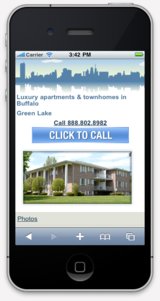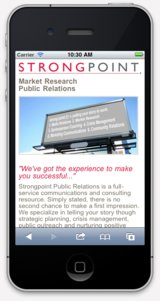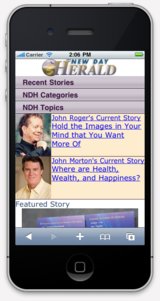The Three Pillars of Mobile
Ask any group of people what they do with their phone besides making calls. The long list will include things like:
- Reading email
- Crossing tasks off their TODO list
- Finding a nearby restaurant
- Searching for facts to answer a question
- Get driving directions
- Text a friend
- Use a mobile coupon
- Read news
- Play a game
- Draw a picture
This rich variety comes from the fact that mobile is not one thing. Rather, mobile is several different things - distinct from each other, yet related. At Mobile Web Up, we've identified what we call the three pillars of mobile:
These are the important mobile channels in the USA, in 2012. Other regions may have a different list, and it will evolve over the coming years. But for American organizations going mobile today, these are the facets of mobile to pay attention to.
These three channels have their own strengths. Let me explain.
First Comparison: Reach
As a starting point, we can ask: what is the potential reach for each channel? In other words, if you create a marketing campaign based on mobile apps; or on the mobile web; or on SMS... what fraction of the total mobile-subscriber population can you theoretically access?
As of May 2013, these percentages are:
| Channel | Reach |
|---|---|
| Mobile Apps | 54.0% |
| Mobile Internet | 52.1% |
| Text Messaging | 75.9% |
These numbers may be different from what you see reported elsewhere, because they account for important, often-missed subtleties - as we will explain below. And of course, the percentages alone are not the whole story. For example, even though SMS has literally twice the reach of mobile apps - a massive advantage - you can do things with apps that may more than make up for it. Let me explain.
Mobile Apps
Mobile apps have one tremendous advantage over mobile websites and SMS: you can create rich, powerfully engaging experiences with apps that are simply not possible with texts, or even the mobile web. It's easy to imagine ways that this can lead to substantial rates of conversion and lead-generation.
Native mobile apps can fully leverage the device because they are, in fact, software that are installed on the smartphone. And today's smartphones are full-fledged computers: they just happen to be smaller than your laptop.
Brands have capitalized off of this flexibility in countless remarkable ways already. Some of these apps even use game-like experiences - like virtually clinking a Heineken bottle, or designing your dream Cartier bridal ring - to engage consumers and stimulate brand awareness in novel ways.
That said, mobile apps have a few disadvantages:
- A native iPhone app cannot be installed on an Android phone; and an Android app cannot run on a Blackberry. In practice, you typically need to fund separate teams for each platform you want your app on... driving up costs very quickly.
- The discovery issue. With over 450,000 Android apps and over 500,000 for iPhone apps, your app needs a marketing budget just for people to know it exists.
- Because publishing even minor improvements to your app requires a formal approval by each individual app store, updating and changing apps is bureaucratic, and potentially expensive. (In comparison, publishing mobile website updates is instant and simple.)
The Platform Issue
In the USA in 2012, the decision of which platforms to support is actually simple for most businesses. If you are creating an app today, you will want to create apps for both iPhone and Android, and omit the others.
This is because of the dominant device market share of each: 23.1% for iPhone, and 30.9% for Android. The third place player, Blackberry (RIM), is so low - 2.8% - that for the vast majority of campaigns, it's not worth the investment to support it. (The exception is when your prospect or client base has a higher than normal proportion of Blackberry users.)
54.2% of all mobile subscribers downloaded and used an app in the same period. However, that is across ALL platforms - an expanse that would be very cost prohibitive for you to support. For most reading this, the ROI will maximize when deploying your app to both iPhone and Android. This is why we set the "reach" of mobile apps to their total market shares, 54.0%.
Text (SMS) Messaging
The great advantage of SMS is its wide reach: 75.9% of all American mobile subscribers. That's far more than any other mobile channel, with the sole exception of voice calls.
(There is an important nuance to this. Nearly 100% of all mobile phones sold in the past year have the technical ability to send and receive SMS. So why do we not say 100%? Because we want to consider only those people who actively compose and send text messages. 75.9% have actually done so in the past 30 days, meaning they will likely be responsive to a well-targeted, opt-in SMS campaign. The rest won't, even if their phone can receive text messages.)
Text messaging has some other outstanding advantages, well highlighted when compared to email marketing. Open rates for marketing emails are under 17%, and may continue to fall. In contrast, SMS marketing messages have open rates of 95% or higher. It literally can't get much higher than that.
And further, the recipient will read your message very quickly after it is sent: different studies indicating a lag time as low as four minutes. Other estimates range as high as fourteen minutes. But even that is nothing compared to the average open time for email: six HOURS.
With all these great advantages, SMS has a downside: you are limited to 160 characters of text per message. This is a much less expressive, less interactive medium that the universes possible with mobile apps.
Fortunately, there is a happy medium.
Mobile Web
The mobile internet combines many of the advantages of both mobile apps and text messaging: a relatively high reach, with many options for rich, engaging experiences leading to measurable increases in conversions and ROI.
About 52.1% of all American mobile subscribers browse the web on their phone. This is far higher than the reach of an iPhone app by itself (23.1%), and significantly above what we call the total mobile app reach (54.0%).
More importantly, mobile websites generally enjoy a much lower cost per reached prospect than an app. Based on our experience working with clients, the cost to create one mobile website that works across all smartphone platforms is often significantly lower than that to create an app for a single platform (e.g., Android), not to mention multiple platforms.
The cost per reached prospect is higher than with text messaging: SMS campaigns generally have a lower cost to set up than a mobile website, yet have higher total reach (75.9%). However, depending on the campaign, this can be offset by the greater control of design, interactivity, and lead generation potential of the mobile site.
Mobile websites enjoy a special benefit over messaging and apps: with a little effort, discovery and usage is automatic. The reason is that most companies have already invested heavily in their web presence, building a website with online relationships; SEO and search marketing; and perhaps ongoing ad spend... all to continually drive qualified traffic to its pages. Mobile websites can benefit from this on day one. In contrast, driving subscribers to your SMS or app campaign requires a separate, substantial marketing initiative.
There are situations for which a mobile site is not appropriate, because app-like features are needed. For example, most native app platforms support "push" notifications, in which a client with your app installed can be directly alerted for special events or promotions. There is currently no way to do this for a mobile website. Very rich, graphical, immersive experiences common with apps, and sensor access like the phone camera, are years away from viability on mobile websites. And native apps will always be able to deliver more polish and functionality than mobile websites.
Fortunately, there are many situations where a mobile website works great - and can even offer app-like experiences that people prefer over "native" apps. A striking example is with mobile Facebook users: their mobile site is more popular than the app, with 18.8% sharing and posting via Facebook's mobile site, versus only 13.9% using the mobile app.
References
Unless otherwise cited, all numbers in this article were based on a Mobile Web Up analysis of data reported in the sources below.
Mobile Web Up makes your existing website mobile
friendly. Get a responsive design that looks
fantastic on hundreds of smartphones, stays in sync with your
main site, is easy for your web team, and nearly future-proof.
Learn more or get started.
Case Studies




"We are very happy with your work... I will recommend Mobile Web Up whenever the opportunity comes up!"Nadine L. Simon, Marketing Director, www.LuxuryAptsWNY.com
"How was the process of working with Mobile Web Up overall? FANTASTIC! I highly recommend Mobile Web Up, without reservation!"Deborah Martinez, Web services manager, MSIA
"I nearly flipped because I knew if I was having trouble loading my website [on my phone], so was everyone else... They worked remarkably fast. I highly recommend asking Mobile Web Up to make your website transition smooth and easy to the mobile universe."Angela K. Lee, L.Ac, A Return To Health Acupuncture
